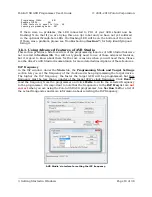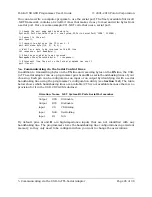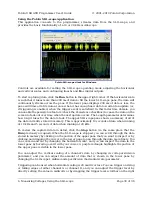
6. Measuring Voltages Using the SLO-scope
A second bonus feature of the Pololu USB AVR programmer is the severely limited
oscilloscope (SLO-scope), which uses lines
A
and
B
as inputs to measure TTL-level voltages
at a sample rate of up to 20 kHz. The SLO-scope has two operating modes:
• Two 8-bit analog channels sampling at 10 kHz
• One 7-bit analog channel (A) and one digital channel (B) sampling at 20 kHz
The SLO-scope can measure voltages between ground and approximately 5 V (depending
on your computer’s USB bus voltage); you can measure higher voltages by passing them
through an external voltage divider before connecting them to the programmer. The
following schematic shows a general voltage divider circuit that can be used to scale down
an input signal to the SLO-scope’s required 0 – 5 V range:
The total resistance of R1+R2 should be as large as possible to minimize the divider’s effect
on your signal, but it should not exceed 100 kΩ or so.
Installing and Runing the Pololu SLO-scope Application
The SLO-scope application for Windows comes with the Windows drivers (
) and
can be installed by running the installation batch file
sloscope_installer.bat
.
Windows Vista:
right click on
sloscope_installer.bat
and select “Run as
administrator”.
Windows XP:
simply double click on
sloscope_installer.bat
.
At this time, the SLO-scope can only be used under the Windows operating system. Once
installation is complete, the application should begin running automatically. Note that the
application will give you an error message and close if a programmer is not connected
to your computer. To start the SLO-scope application yourself, open the Start menu and
navigate to:
All Programs > Pololu > SLO-scope
The SLO-scope application was written as a Visual C# 2008 project. We will be making the
application code open source shortly (i.e. once it is sufficiently cleaned up and presentable).
Pololu USB AVR Programmer User's Guide
© 2001–2010 Pololu Corporation
6. Measuring Voltages Using the SLO-scope
Page 29 of 36






















